BUICK REGAL 1998 Owners Manual
Manufacturer: BUICK, Model Year: 1998, Model line: REGAL, Model: BUICK REGAL 1998Pages: 388, PDF Size: 20.19 MB
Page 271 of 388
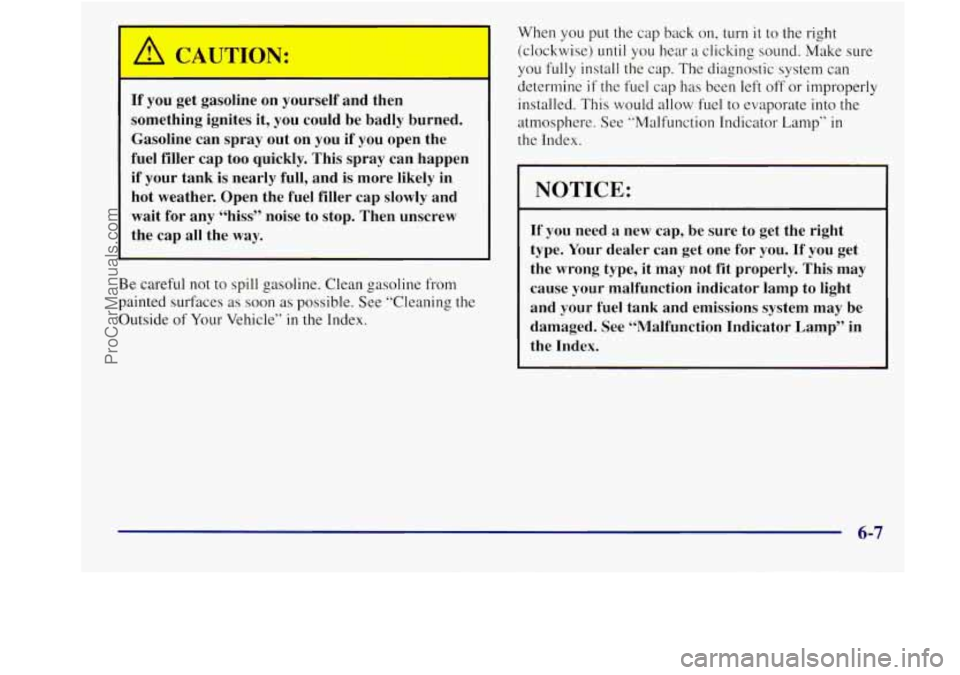
If you get gasoline on yourself and then
something ignites it, you could be badly burned.
Gasoline can spray out on you if you open the
fuel filler cap too quickly. This spray can happen
if your tank is nearly full, and is more likely in
hot weather. Open the fuel filler cap slowly and
wait for any “hiss” noise to stop. Then unscrew
the cap
all the way.
Be careful not to spill gasoline. Clean gasoline from
painted surfaces
as soon as possible. See “Cleaning the
Outside
of Your Vehicle” in the Index. When you
put the cap back on, turn
it to the right
(clockwise)
until you hear a clicking sound. Make sure
you
fully install the cap. The diagnostic system can
determine
if the fuel cap has been left off or improperly
installed. This would allow fuel to evaporate into the
atmosphere. See “Malfunction Indicator Lamp”
in
the Index.
NOTICE:
If you need a new cap, be sure to get the right
~ type. Your dealer can get one for you. If you get
the wrong type, it may not fit properly. This may
’ cause your malfunction indicator lamp to light
and
your fuel tank and emissions system may be
damaged. See “Malfunction Indicator Lamp” in
the Index.
6-7
ProCarManuals.com
Page 272 of 388
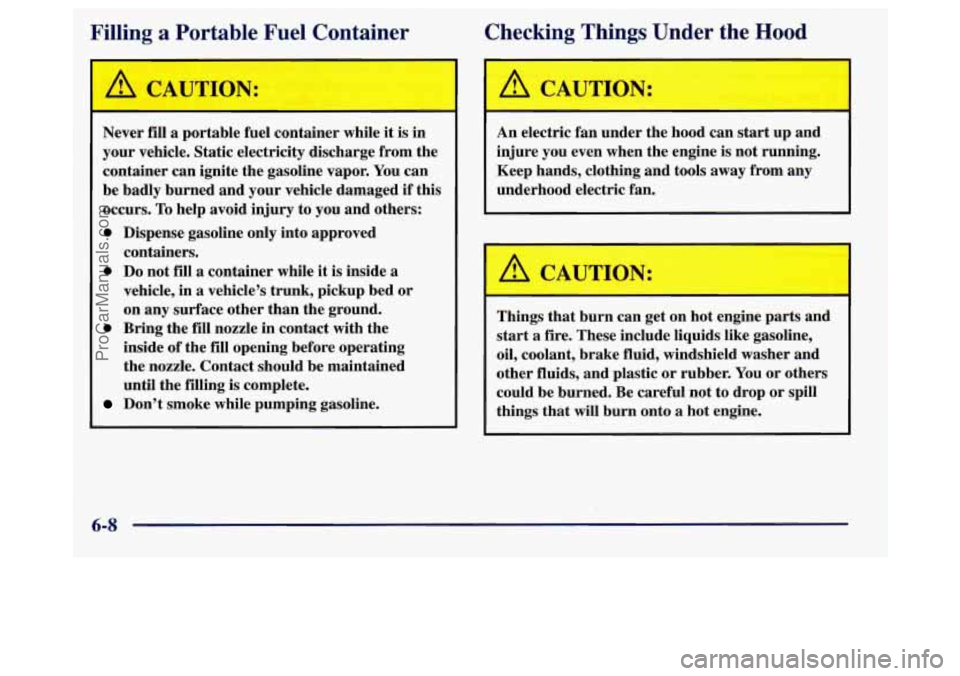
Filling a Portable Fuel Container Checking Things
Under the Hood
Never fill a portable fuel container while it is in
your vehicle. Static electricity discharge from the
container can ignite the gasoline vapor. You can
be badly burned and your vehicle damaged
if this
occurs. To help avoid injury to you and others:
0 Dispense gasoline only into approved
containers.
0 Do not fill a container while it is inside a
vehicle, in a vehicle's trunk, pickup bed or
on any surface other than the ground.
inside of the fill opening before operating
the nozzle. Contact should be maintained
until the filling is complete.
0 Bring the fill nozzle in contact with the
Don't smoke while pumping gasoline. An
electric fan under the hood can start up and
injure you even when the engine
is not running.
Keep hands, clothing and tools away from any
underhood electric fan.
1
Things that burn can get on hot engine parts and
start a fire. These include liquids like gasoline,
oil, coolant, brake fluid, windshield washer and
other fluids, and plastic or rubber. You or others
could be burned. Be careful not to drop or spill
things that will burn onto a hot engine.
6-8
ProCarManuals.com
Page 273 of 388
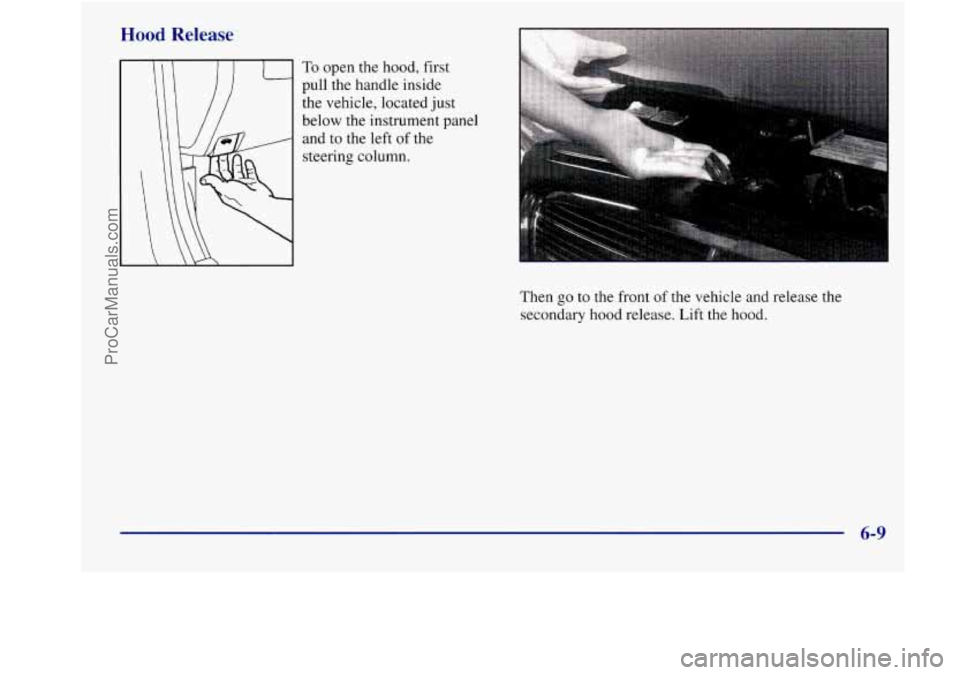
Hood Release
To open the hood, first
pull the handle inside
the vehicle, located just
below the instrument panel
and to the left of the
steering column.
Then go to the front of the vehicle and release the
secondary hood release. Lift the hood.
6-9
ProCarManuals.com
Page 274 of 388
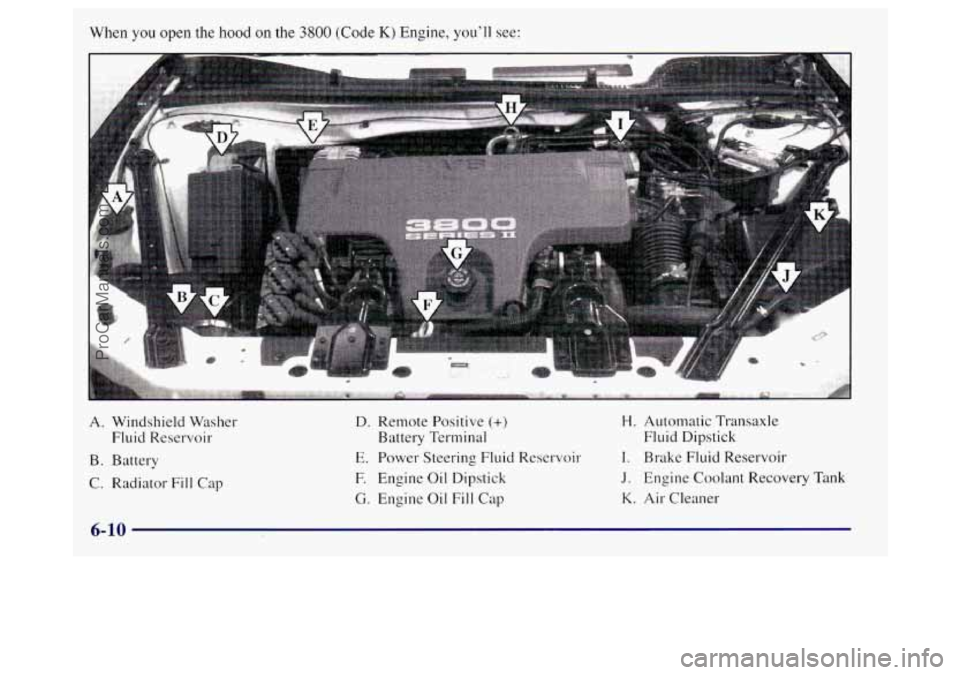
When you open the hood on the 3800 (Code K) Engine, you’ll see:
A. Windshield Washer
Fluid Reservoir
B. Battery
C. Radiator Fill Cap
D. Remote Positive (+)
Battery Terminal
E. Power Steering Fluid Reservoir
F. Engine Oil Dipstick
G. Engine Oil Fill Cap
H. Automatic Transaxle
I. Brake Fluid Reservoir
J. Engine Coolant Recovery Tank
K. Air Cleaner
Fluid
Dipstick
ProCarManuals.com
Page 275 of 388
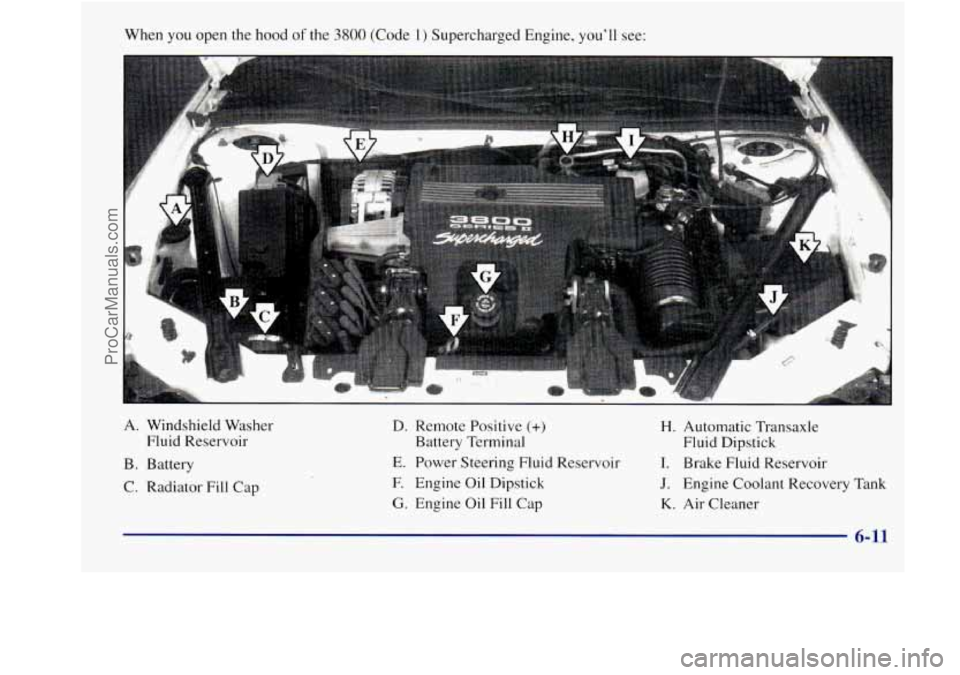
When you open the hood of the 3800 (Code 1) Supercharged Engine, you’ll see:
H
A. Windshield Washer
Fluid Reservoir
B. Battery
C. Radiator Fill Cap
D. Remote Positive (+) H. Automatic Transaxle
E. Power Steering Fluid Reservoir I. Brake Fluid Reservoir
E Engine Oil Dipstick J. Engine Coolant Recovery Tank
G. Engine Oil Fill Cap K. Air Cleaner
Battery Terminal
Fluid Dipstick
6-11
ProCarManuals.com
Page 276 of 388
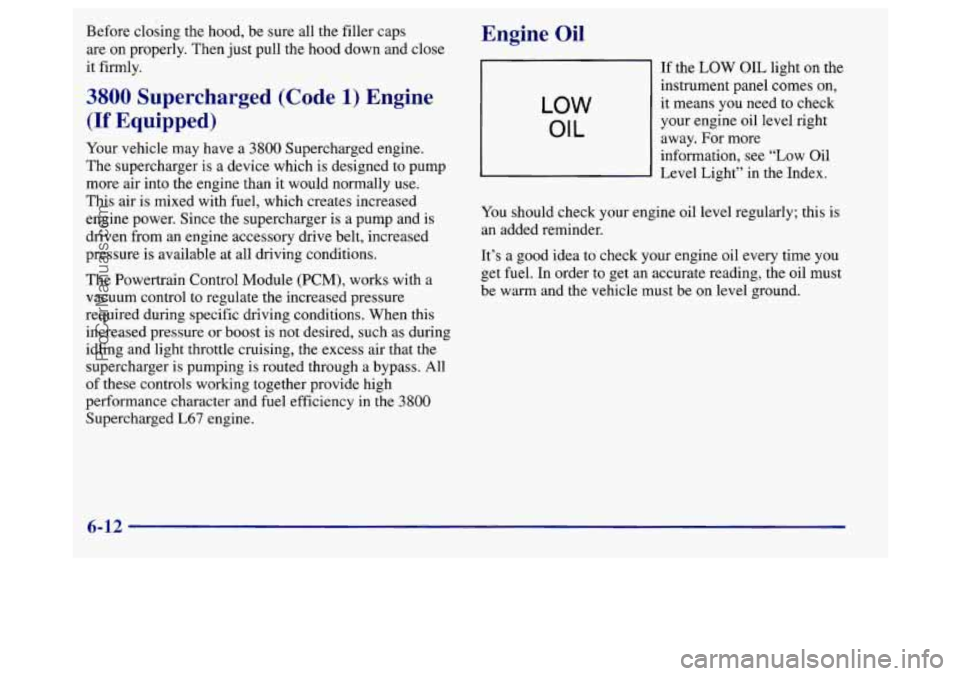
Before closing the hood, be sure all the filler caps
are on properly. Then just pull the hood down and close
it firmly.
3800 Supercharged (Code 1) Engine
(If Equipped)
Your vehicle may have a 3800 Supercharged engine.
The supercharger is a device which is designed to pump
more air into the engine than it would normally use.
This
air is mixed with fuel, which creates increased
engine power. Since the supercharger is a pump and is
driven from an engine accessory drive belt, increased
pressure
is available at all driving conditions.
The Powertrain Control Module (PCM), works with a
vacuum control to regulate the increased pressure
required during specific driving conditions. When this
increased pressure or boost is not desired, such as during
idling and light throttle cruising, the excess air that the
supercharger is pumping is routed through a bypass. All
of these controls working together provide high
performance character and fuel efficiency in the
3800
Supercharged L67 engine.
Engine Oil
LOW
OIL
If the LOW OIL light on the
instrument panel comes on,
it means you need to check
your engine oil level right
away. For more
information,
see “Low Oil
Level Light” in the Index.
You should check your engine oil level regularly; this
is
an added reminder.
It’s a good idea to check your engine oil every time you
get fuel. In order to get an accurate reading, the oil must
be warm and the vehicle must be on level ground.
6-12
ProCarManuals.com
Page 277 of 388
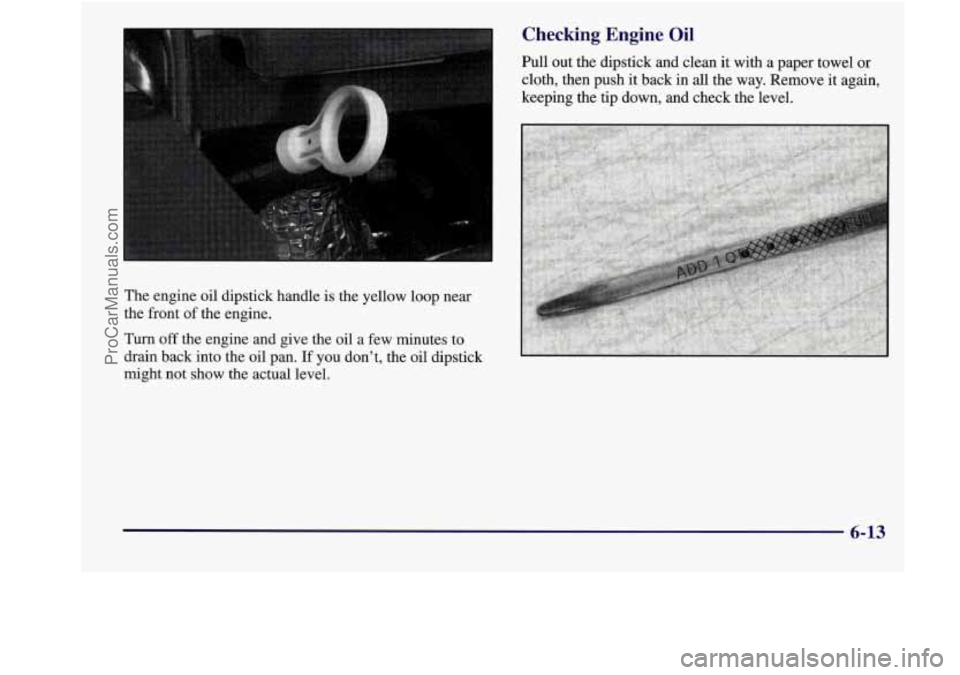
Checking Engine Oil
Pull out the dipstick and clean it with a paper towel or
cloth, then push it back in all the way. Remove it again,
keeping the tip down, and check the level.
The engine oil dipstick handle is the yellow loop near
the front
of the engine.
Turn
off the engine and give the oil a few minutes to
drain back into the oil pan.
If you don't, the oil dipstick
might not show the actual level.
6-13
ProCarManuals.com
Page 278 of 388
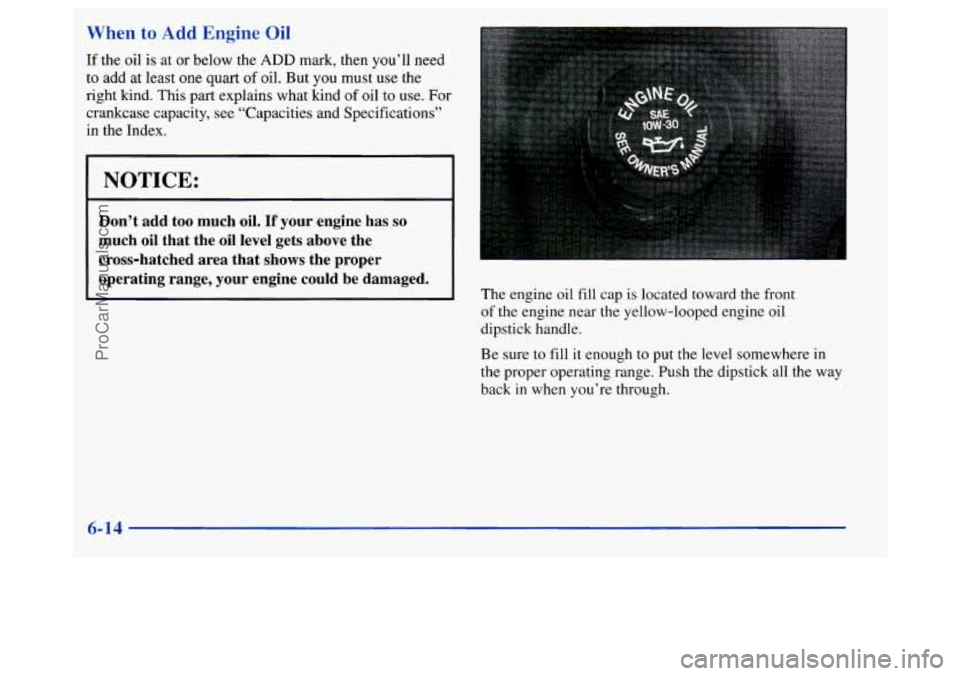
When to Add Engine Oil
If the oil is at or below the ADD mark, then you’ll need
to add at least one quart of oil. But you must use the
right kind. This part explains what kind
of oil to use. For
crankcase capacity, see “Capacities and Specifications’’
in the Index.
NOTICE:
Don’t add too much oil. If your engine has so
much oil that the oil level gets above the
cross-hatched area that shows the proper
operating range, your engine could be damaged.
The engine oil fill cap is located toward the front
of the engine near the yellow-looped engine oil
dipstick handle.
Be sure to fill it enough to put the level somewhere in
the proper operating range.
Push the dipstick all the way
back in when you’re through.
6-14
ProCarManuals.com
Page 279 of 388
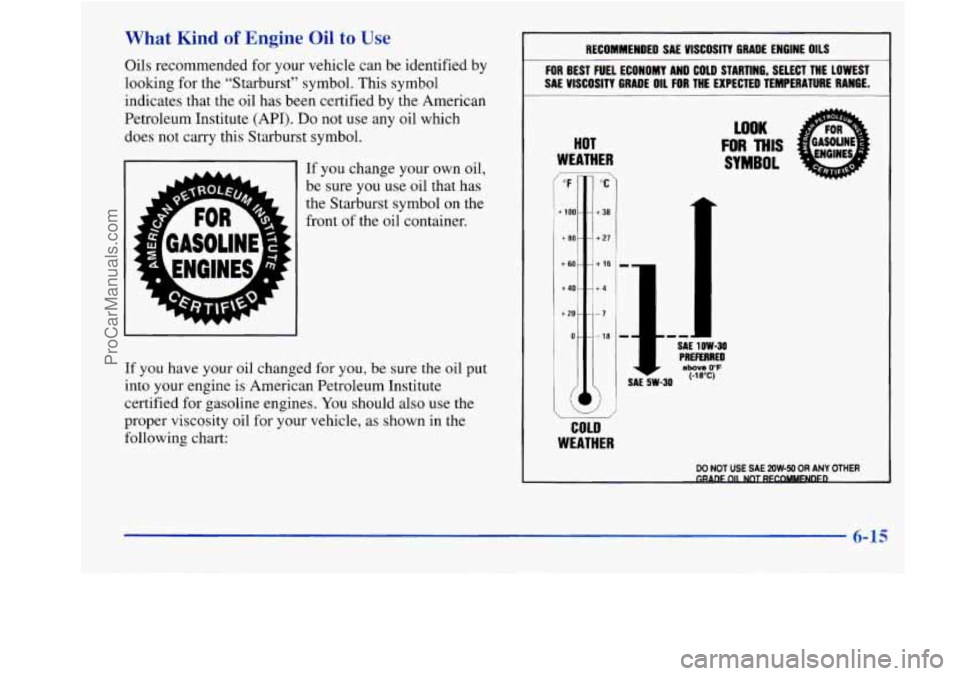
What Kind of Engine Oil to Use
Oils recommended for your vehicle can be identified by
looking for the “Starburst” symbol. This symbol
indicates that the oil has been certified by the American
Petroleum Institute (API).
Do not use any oil which
does not carry this Starburst symbol.
If you change your own oil,
be sure
you use oil that has
the Starburst symbol on the
front of the oil container.
I RECOMMENDED SAE VISCOSITY GRADE ENGINE OILS
If you have your oil changed for you, be sure the oil put
into your engine is American Petroleum Institute
certified for gasoline engines. You should also use the
proper viscosity oil for your vehicle, as shown in the
following chart:
L
FOR BEST FUEL ECONOMY AND COLD STARTINC;, SELECT THE LOWEST
1 SAE VISCOSITY GRADE OIL FOR THE EXPECTED TEMPERATURE RANGE.
HOT
WEATHER
’TC)
SAE 1OW-30 PREFERRED above 0°F (-18°C)
LOOK
FOR THIS
SYMBOL
COLD
WEATHER
DO NOT USE SAE 2OW-50 OR ANY OTHER FD
6-15
ProCarManuals.com
Page 280 of 388
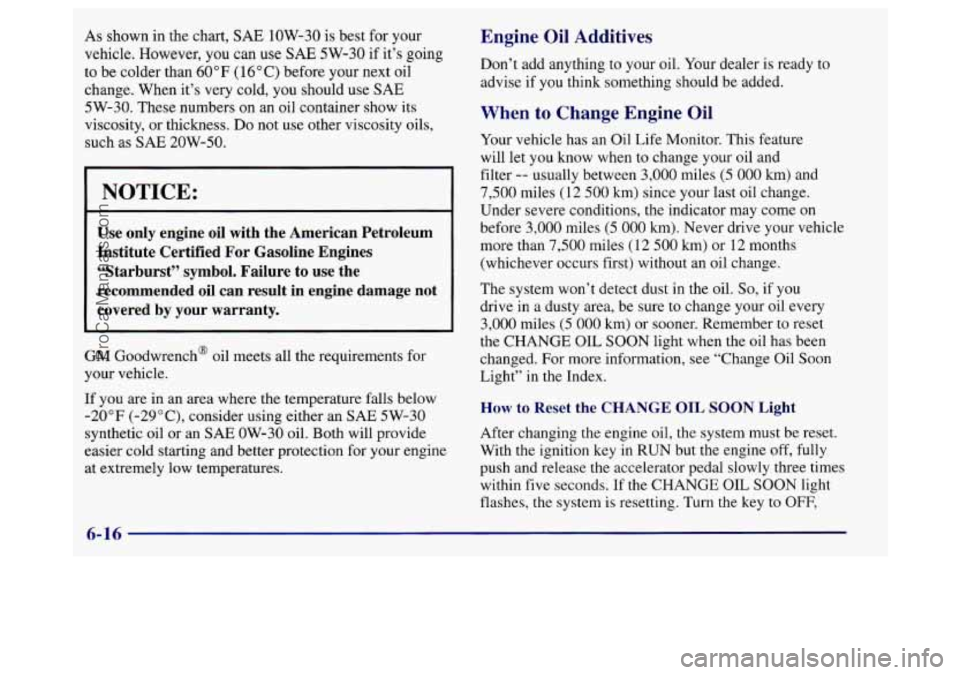
As shown in the chart, SAE 1OW-30 is best for your
vehicle. However, you can
use SAE 5W-30 if it’s going
to be colder than
60°F (1 6 O C) before your next oil
change. When it’s very cold,
you should use SAE
5W-30. These numbers on an oil container show its
viscosity, or thickness.
Do not use other viscosity oils,
such
as SAE 20W-50.
NOTICE:
Use only engine oil with the American Petroleum
Institute Certified For Gasoline Engines
“Starburst” symbol. Failure to use the
recommended oil can result in engine damage not
covered by your warranty.
GM Goodwrench@ oil meets all the requirements for
your vehicle.
If you are in an area where the temperature falls below
-20°F
(-29”C), consider using either an SAE 5W-30
synthetic oil or an SAE OW-30 oil. Both will provide
easier cold starting and better protection for your engine
at extremely low temperatures.
Engine Oil Additives
Don’t add anything to your oil. Your dealer is ready to
advise if you think something should be added.
When to Change Engine Oil
Your vehicle has an Oil Life Monitor. This feature
will let you know when to change your oil and
filter
-- usually between 3,000 miles (5 000 km) and
7,500 miles (12 500 km) since your last oil change.
Under severe conditions, the indicator may come on
before
3,000 miles (5 000 km). Never drive your vehicle
more than
7,500 miles (12 500 km) or 12 months
(whichever occurs first) without an oil change.
The system won’t detect dust
in the oil. So, if you
drive in a dusty area, be sure to change your oil every
3,000 miles (5 000 km) or sooner. Remember to reset
the CHANGE OIL
SOON light when the oil has been
changed. For more information, see “Change Oil Soon
Light” in the Index.
How to Reset the CHANGE OIL SOON Light
After changing the engine oil, the system must be reset.
With the ignition key in RUN but the engine off, fully
push and release the accelerator pedal slowly three times
within five seconds. If
the CHANGE OIL SOON light
flashes, the system is resetting.
Turn the key to OFF,
6-16
ProCarManuals.com